Samaaro + Your CRM: Zero Integration Fee for Annual Sign-Ups Until 30 June, 2025
- 00Days
- 00Hrs
- 00Min
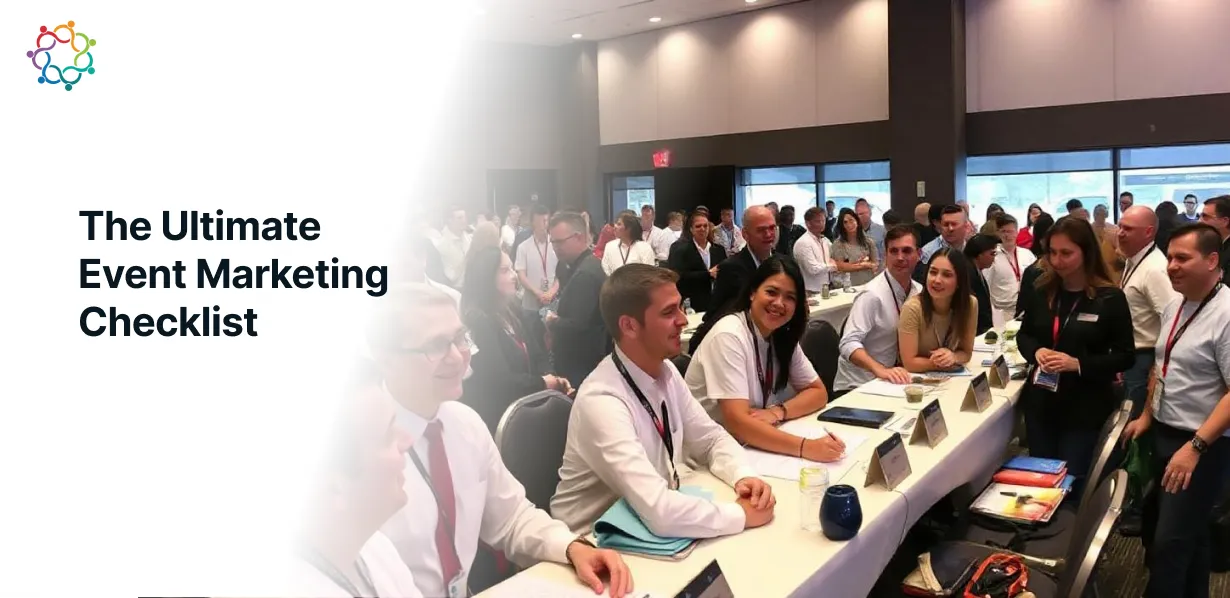
Did you know that events that have a clearly defined marketing plan see a 30% uptick in attendance and 20% more leads? Event marketing strategy doesn’t just create noise; it measures impact. This checklist is your master plan! The list can take you from start to finish on every aspect of event marketing while ensuring your event is ultimately successful!
Why use a checklist?
Consider this checklist as your checklist to combat chaos through marketing!
This will be of big value because:
Well Organized: Once you create the plan of time, you don’t have to waste time trying to figure it out at the last minute.
Efficient Workflow: You will have broken down your marketing into tasks, so you can have a good plan without worrying if you are missing anything important.
Mitigate Risks: By having the checklist created ahead of time, you have lowered your risk of not completing an important step.
Pre-event marketing: setting the table
Okay the excitement is growing for your event, but before you step on the gas in the promotional work in the next 6 months, it’s important to build the foundation. The next 6 months is the time to build a narrative, figure out who your target audience is, and decide which channels are most effective to reach your target audience. Pre-event marketing is your time to build evidence for a successful and attended event:
SMART Goals & target audience: Establish the reasons for your event (brand awareness, lead generation) and develop an ideal customer persona by knowing their target audience (age, interests, pain points).
Brand Image & Messaging:
You should create a brand presence and messaging consistent with the audience and to put that through your marketing materials.
Channel Selection:
Choose the channels to reach your audience. Social media, e-mail marketing, paid advertising, and trade publications should all be assessed in regard to your target audience’s awareness.
Event Website and the Use of Landing Pages:
You should create a website experience that communicates all the necessary data about your event (speakers, agenda, etc.) and make it simple for attendees to register, learn about the program, and be sure your event comes off seamless. This is also the time to create landing pages for lead captures and make sure those leads convert.
Content Marketing Calendar:
You will want to plan and create valuable content (blogs, videos, infographics) educate your audience, develop the maximum amount of anticipation for your event, and further your positioning as a thought leader in the industry.
Speakers/Sponsors:
In your event planning process, get speakers who can speak to the theme of your event, but also think about if you can find brand partners who can provide some value to your offering and extend your reach respectively.
Pre-Event Marketing: Build Engagement
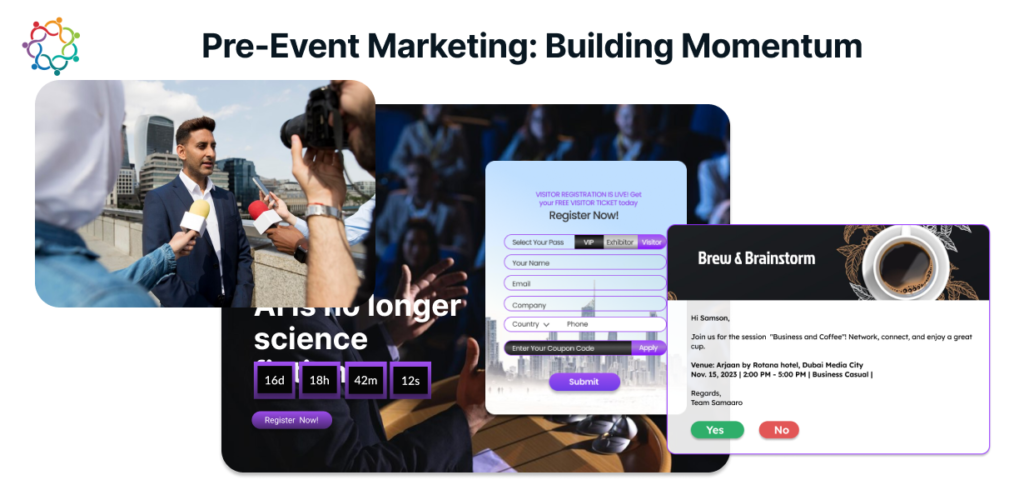
You’ve done the heavy lifting for your event plan, now it’s time to ramp up the excitement. As you enter June, you are at the three-month out countdown. Your success will now depend on excitement and awareness, so this pre-event marketing phase is built to develop social media campaigns and conduct email outreach to convert registrations and ensure the potential for your event is fulfilled:
Social Media Stage:
Set the stage for your social media campaign to start with engaging content, thumbnails, teasers for the event including paid advertising with promotion to widen your audience potential.
Email Marketing Stage:
Create segmented email marketing campaigns with specific audience segments, develop educational emails about the event to go to past attendees (if have one) and contents focused to nurture leads and shared valuable content.
PR Outreach:
Develop strategic press releases and media pitches that get media coverage and create hype for your event.
Registration Process:
Create a registration process on your event website that is easy to use, ensuring that it is efficient and effortless for the attendees.
Promotional Materials:
Create digital and print promotional materials (email banners, social media graphics, flyers) that showcase your brand identity and communicate the event’s value effectively.
Pre-Event Marketing: The Final Push
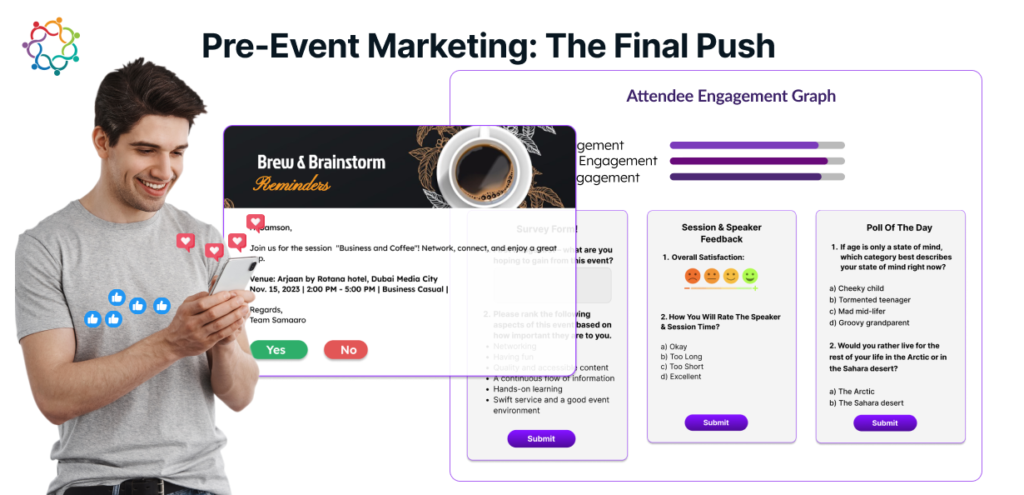
With one month to go until your event, it is time to re-evaluate where you are with your pre-event marketing and make a big final push so you can maximize attendance and ensure an incredible experience. Here are ways to make your push for pre-event marketing actionable:
Social Media Phase:
In this phase, you Schedule your social media campaign to begin with highly engaging content, captivating thumbnails, teaser content for the event, including paid promotion for paid advertising to help expand your potential audience.
Email Marketing Phase:
In this stage, you can segment your target audience, create email campaigns from segmented audience, you can also develop educational email regarding the event to send out to past attendees (if you have one), and the content can nurture leads and valuable content to share.
Publicity Outreach: You can create media releases and press pitches that will gain media placement and excitement for your event.
Registration Route: You can develop a registration route on your event website that is easy for the user and provides an easy experience for your attendees.
Promotional Materials: You can develop online and print marketing materials (email banners, social media graphics, flyers) that represent your brand identity as well as the value of the event.
Event Marketing: Fuel the Fire
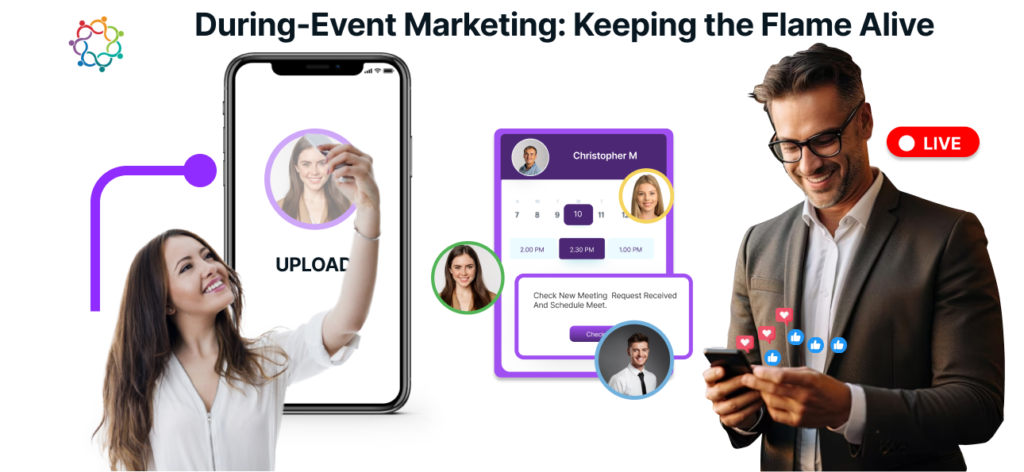
The months of planning will finally take shape into an unforgettable learning experience at event time, but you still have some managing to do. During event marketing is to keep it going, reconnecting with your audience and getting some good feedback. Let us consider some ways to fuel the fire and make your event experience unforgettable:
Pre-Event Social Media:
Make sure the hype on social media continues, w/ countdowns that include high energy graphics or attention-grabbing images, behind the scenes event prep shots, and of course the official hashtag. Hopefully, you have engaged your audience by asking the questions or polls around your theme.
On-Site Registration:
Make the on-site registration process as easy as possible. Utilize friendly personable staff, signs, registration materials, etc., to set a friendly and inviting atmosphere from the moment your attendees walk into your venue.
Live Social Media:
Keep engaging your audience w/ live social media updates throughout your event. You can engage your entire audience by sharing images from presentations, videos from speaker highlights, and quotes. You can also ask attendees to join the social media fun. It would be a win-win to foster connection and brand relationships and also create a meaningful experience in which the attendee values more than simply the intended content of the event.
Collecting Feedback:
Utilize feedback surveys or polls in-session or after to capture the experiences of the participants. This is critical as it is vital to get a sense of what the audience resonated with and areas for future improvement. Be sure to take your time before you write even the surveys and think about ease + accessibility to ensure strong participation and quality data to help next time!
Post Event Marketing: Impact:
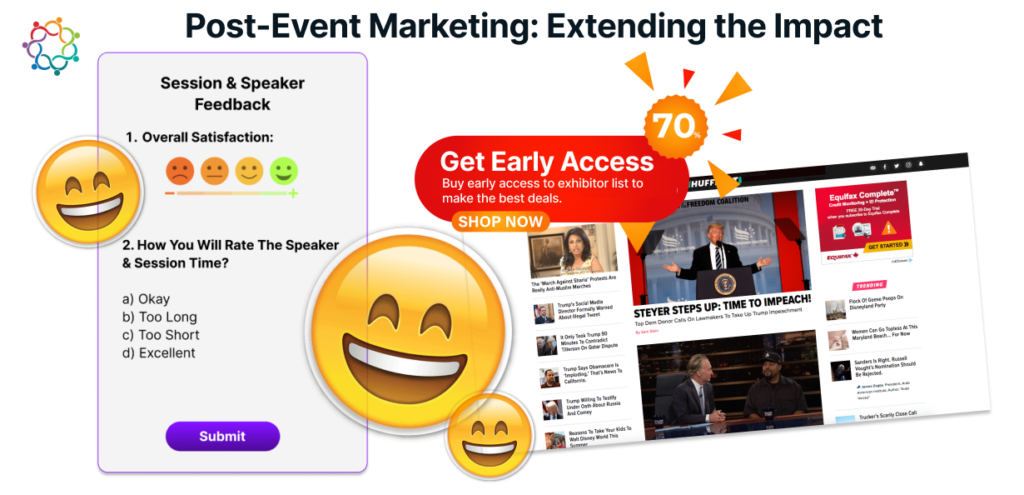
The hype might be over but the relationships you’ve created and value you provided have lasting impact.
Post-event marketing is now about extending impact, creating relationships, and positioning attendees into brand advocates. Here’s how to keep the conversation going!
Surveying Participants post event:
Surveys/polls (e.g., via email or a dedicated landing page) can be used to get feedback about their experience while also inquiring about the content, speaker/engagement, and overall satisfaction with the event. It is helpful to know what you did well and what you could still improve on for future iterations.
Promoting the Events:
Consider writing some engaging blog posts, social media posts, or email newsletters to promote the best parts of the meeting! Incorporate some excellent pictures from the event, include quotes from the presenters, and also a few testimonials from attendees. This will help, as it will be a great reminder to your attendees what value they received, as well as get new attendees engaged!
Nurturing Leads:
After each meeting, send a follow email to attendees you were able to connect with personally. Go through each lead, read the comments about what they are interested in, and reach out to them individually. Share them relevant information related to what was talked about at the meeting, and some special deals for their feedback or for access for the next meeting. By following through, you show that you not only connected with them, but you also raised your brand awareness in a positive way.
6. Post-Event Marketing: Measuring the Success (1 Month After)
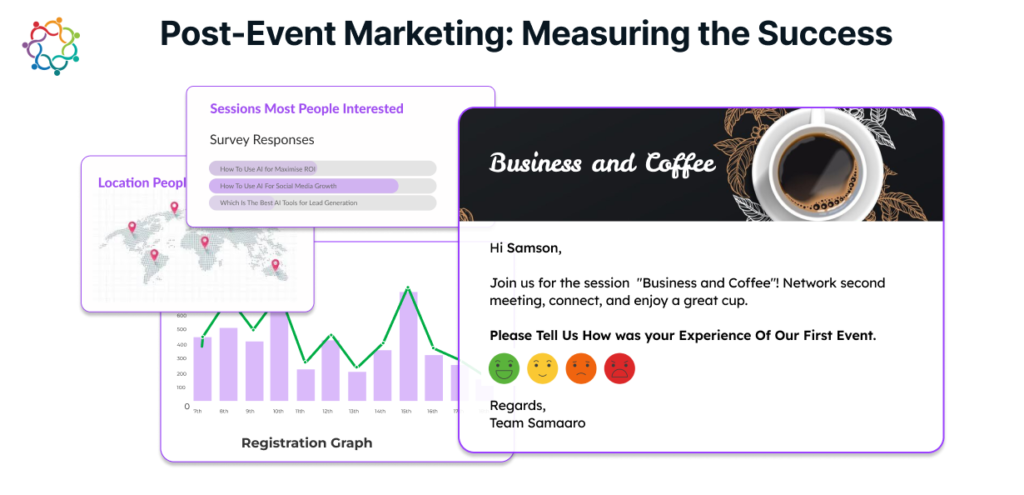
The applause has stopped, but learning should not end there. One month after your event, you want to go back in and assess the data and determine how successful or unsuccessful your marketing actions were. This post event analysis should be a way for you to assess your data, their feedback, and ROI to assess what can be improved on for you to create and plan better events in the future.
Hybrid event data evaluation:
This means you should be evaluating the data you received about web traffic, registration details and survey information. You will want to delve into what metrics you are measuring especially ROI, attendee demographics, and attendee engagement. Data evaluation will give you feedback about the event you put on, areas to work on, and important information for use with your next events, this data will also start to establish a base for your plan.
Engaging post-event:
Send your attendees a personalized email thanking them for attending and then engage them in the post-event communication by sharing information in your industry, upcoming events, or added content that is exclusive to their attendance; you want to keep these contacts top of mind, and you can build a longer-term relationship with Your Event Marketing Tool Kit
Now that you have your checklist of items to execute your event marketing strategy, let’s look at some tools that will make things easy for you and your participants!
Event Management Tools
Many platforms exist like Samaaro, that relieve the burden of event management by providing tools that can help you handle registration, marketing automation and attendance tracking. These tools offer massive efficiencies, relieving the burden on you and giving you more time to focus on your event strategy and guest engagement.
Content Marketing Tools
Content marketing and creation is important relating to pre-event promotion. For example, tools like Canva, Adobe Spark, and Lumen5 are user-friendly at helping you create attention-grabbing graphics, infographics, and short videos, you can then promote your event across many channels.
Social Media Management Tools
Social media management tools can help you streamline and control your social media posts. For example, Hootsuite, Buffer, and Sprout Social provide features that allow you to schedule all your posts at a later date and track tracking metrics to measure your engagement and post performance. In addition, being able to engage with your audience on numerous social media platforms, likely means that you’re spending less time worrying about your posting schedule, and can feel more reassured that your brand has a consistent identity across each channel.
Analytics & Reporting Tools
Analytics tools are powerful and can hopefully give you valuable insights regarding your event marketing strategy. Google analytics, and social media platform analytics provide powerful data around website traffic, social interactions and engagement, registrant conversion rates, and campaign success. In turn, there is something to discuss after you examine the posts, user-analytics which will provide you with things to contemplate when understanding where you are excelling but also understanding where you can adjust or pivot your marketing strategy going forward, in advance of other future events.
Conclusion
In conclusion, effective events can emerge from careful planning and execution, along a road map or marketing plan. You will use this checklist and tools available today to create a very effective event marketing plan specifically designed for increasing guest engagement, establishing marketing effectiveness, and achieving your event objectives.
And don’t stop here! Sign up for our newsletter for additional event marketing tips and industry changes, and downloadable resources and strategies that will help make your events impactful. Also, please share this checklist with your event planner and marketer colleagues so we can work to deliver the best event experience we can together!
Are you ready to elevate your events?! Book a demo and start your free trial today!

Built for modern marketing teams, Samaaro’s AI-powered event-tech platform helps you run events more efficiently, reduce manual work, engage attendees, capture qualified leads and gain real-time visibility into your events’ performance.
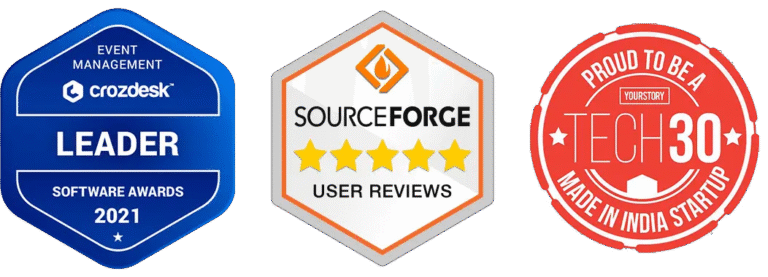
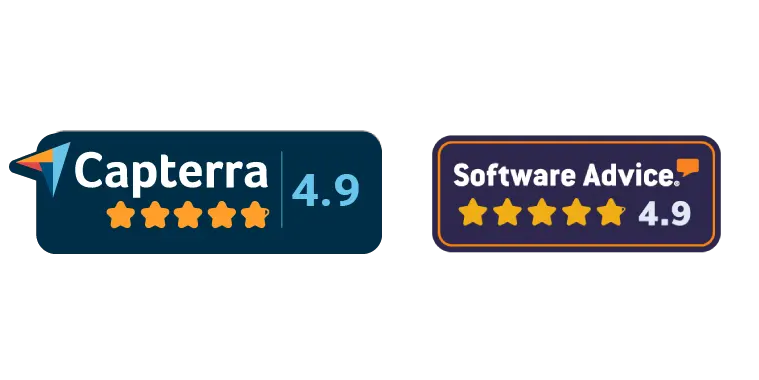
© 2025 — Samaaro. All Rights Reserved.